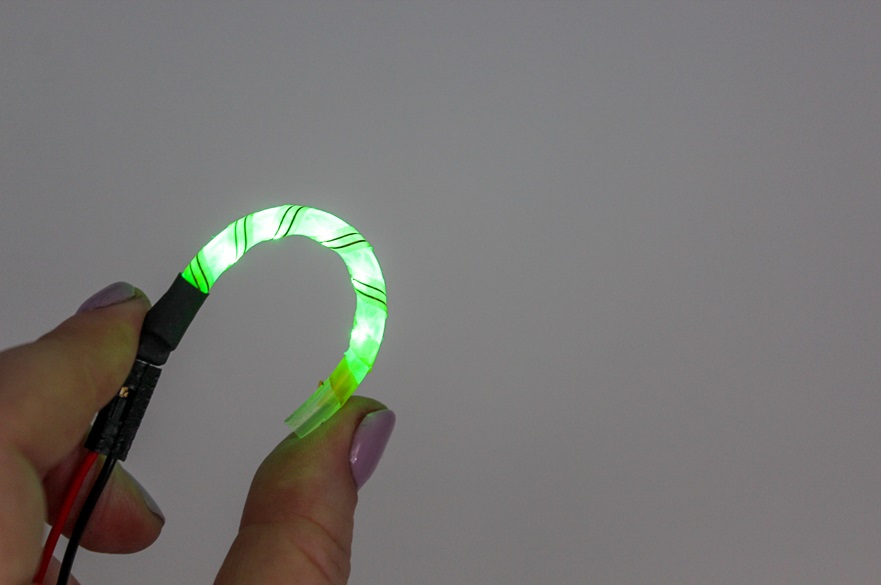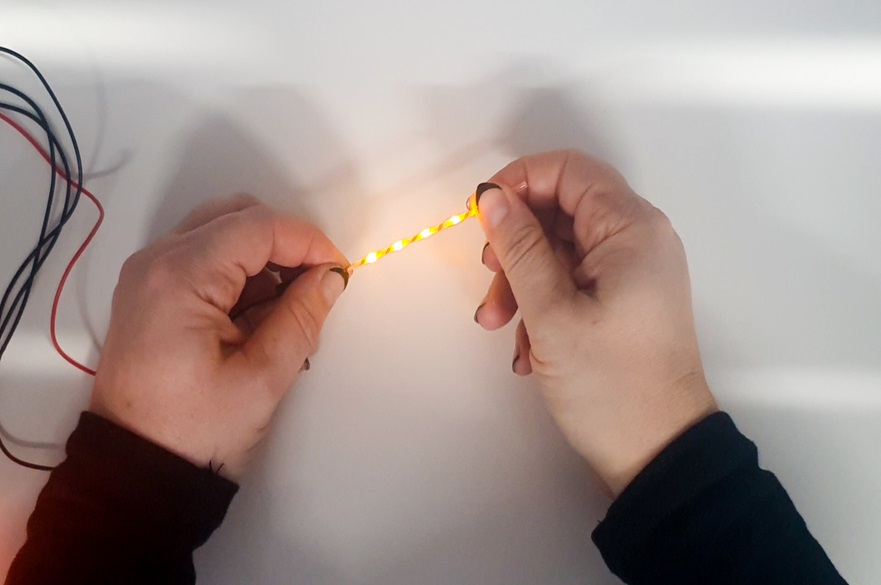Novel 3D stretchable electronic strip could spark new possibilities for wearable e-textiles
Researchers have developed a novel 3D stretchable electronic strip which is expected to open up a range of new possibilities in wearable electronic textiles.
By Dave Rogers | Published on 2 July 2024
Categories: Press office; Research; School of Science and Technology;

A team at Nottingham Trent University’s Medical Technologies Innovation Facility has led the work, which has paved the way for a new generation of electronic devices which could be embedded in clothing for possible use in healthcare and elite sports settings.
The researchers argue that the new strip has significant benefits and functionality over existing technologies due to its ability to stretch and bend with the body.
The strip’s 3D structure, whereby the circuitry is twisted to form a helical ribbon, transforms it from flexible to stretchable with the ability to bend in multiple directions – rather than just one – and stretch up to at least half its initial size.
Stretchability is considered important because many textiles are stretchable, such as medical compression garments or sportswear, where clothing must not restrict the wearer’s movement.
The researchers demonstrated LED and temperature sensing helical e-strips as part of the study. A rubber cord supports the structure and helps to prevent damage from buckling and consideration was given to compatibility with clothing and washability.
“We have been able to show the potential for a new form of 3D helical strip for embedded electronics in e-textiles,” said Dr Yang Wei, an expert in electronic textiles and electronic engineering at Nottingham Trent University and the principal investigator of the research.
He said: “We have defined the design, developed prototypes, performed mechanical testing and validated the functionality of the concept. This opens up a range of new possibilities for e-textiles for possible future use in healthcare and elite sports settings.”

Lead author Jessica Stanley, a research fellow in the university’s Medical Technologies Innovation Facility and Department of Engineering, said: “The basic idea has been around for centuries; it's the same concept as taking a metal wire and making it stretchy by winding it into a spring. While helices have already been used in stretchable electronic devices, up to now they have only been used as interconnects – wires that connect parts of a circuit – or single components.
“What sets our work apart is that strips of flexible circuitry containing small components, circuits more complex than a single wire or printed component, are wound into a helix, so that the entire circuit can stretch.
“Because many e-textile products need to be stretchy it is important to have stretchable electronic parts that can move and stretch with the fabric. This study documents our initial work on a new way to achieve this.”
The technology has been patented which it is hoped will allow for faster uptake by industry.
The research, which also involved industry partner Kymira Ltd, is published in the Nature journal Scientific Reports.
Notes for Editors
Press enquiries please contact Dave Rogers, Public Relations Manager, on telephone +44 (0)115 848 8782, or via email.
Nottingham Trent University (NTU) received the Queen’s Anniversary Prize for Higher and Further Education in 2021 for cultural heritage science research. It is the second time that NTU has been bestowed the honour of receiving a Queen’s Anniversary Prize for its research, the first being in 2015 for leading-edge research on the safety and security of global citizens.
The Research Excellence Framework (2021) classed 83% of NTU’s research activity as either world-leading or internationally excellent. 86% of NTU’s research impact was assessed to be either world-leading or internationally excellent.
NTU was awarded The Times and The Sunday Times Modern University of the Year 2023 and ranked University of the Year in the Whatuni Student Choice Awards 2023. It was awarded Outstanding Support for Students 2020 (Times Higher Education Awards), University of the Year 2019 (Guardian University Awards, UK Social Mobility Awards), Modern University of the Year 2018 (Times and Sunday Times Good University Guide) and University of the Year 2017 (Times Higher Education Awards).
NTU is the 5th largest UK institution by student numbers, with approximately 40,000 students and more than 4,400 staff located across five campuses. It has an international student population of 7,000 and an NTU community representing over 160 countries.
Since 2000, NTU has invested £570 million in tools, technology, buildings and facilities.
NTU is in the UK’s top 10 for number of applications and ranked first for accepted offers (2021 UCAS UG acceptance data). It is also among the UK’s top five recruiters of students from disadvantaged backgrounds and was the first UK university to sign the Social Mobility Pledge.
NTU is ranked the second most sustainable university in the world in the 2022 UI Green Metric University World Rankings (out of more than 900 participating universities).